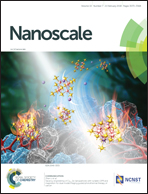MoSx-coated NbS2 nanoflakes grown on glass carbon: an advanced electrocatalyst for the hydrogen evolution reaction†
Abstract
Recent experimental and theoretical studies have demonstrated that two-dimensional (2D) transition metal dichalcogenide (TMDC) nanoflakes are one of the most promising candidates for non-noblemetal electrocatalysts for hydrogen evolution reaction (HER). However, it is still challenging to optimize their conductivity and enrich active sites for highly efficient electrochemical performance. Herein, we report a chemical vapor deposition (CVD) and thermal annealing two-step strategy to controllably synthesize hybrid electrocatalysts consisting of metallic NbS2 nanoflake backbones and a highly catalytic active MoSx nanocrystalline shell on polished commercial glass carbon (GC). In addition, the amount of MoSx in the hybrids can be easily adjusted. We first demonstrate that a small amount of MoSx significantly promotes the HER activity of 2D NbS2 nanoflakes, which is in good agreement with the density functional theory (DFT) calculation results. Moreover, the optimized MoSx@NbS2/GC electrocatalyst displays superior HER activity with overpotential of −164 mV at −10 mA cm−2, a small Tafel slope of 43.2 mV dec−1, and prominent electrochemical stability. This study provides a new path for enhancing the HER performance of 2D TMDC nanoflakes.



 Please wait while we load your content...
Please wait while we load your content...